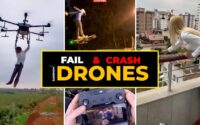Drones and Audio Recording – Applications, Regulations, and Ethical Considerations
Drones can record audio, capturing sounds from their surroundings with built-in or external microphones. They have applications in surveillance, filmmaking, wildlife monitoring, and more. However, legal restrictions and privacy concerns must be respected to ensure ethical and lawful use of this technology.
Can Drones Record Audio?
Can Drones Record Audio? The answer is yes – drones equipped with audio recording capabilities can capture sound. These unmanned aerial vehicles (UAVs) have advanced technology that enables them to not only capture high-resolution images and videos but also record audio. With the help of built-in or externally attached microphones, drones can record various sounds from their surroundings. This opens up a range of applications, including aerial surveillance, filmmaking, wildlife monitoring, and more. However, it’s important to note that privacy concerns and legal restrictions may apply when it comes to recording audio with drones. It’s essential to respect local laws and regulations to ensure ethical and lawful use of this technology.
The Technology Behind Drone Audio Recording
Drones have revolutionized various industries with their ability to capture stunning aerial footage, but did you know they can also record high-quality audio? – Yes, they can! The advancement in drone technology has made it possible to capture not only visuals but also audio from the sky. Let’s explore the key aspects of drone audio recording.
-
Microphones: Drones are equipped with built-in microphones that capture audio directly from the surroundings. These microphones are designed to reduce wind noise and deliver clear sound recordings.
-
Directional Audio: Some drones come with advanced directional audio technology, allowing them to focus on specific sounds or voices. This feature is particularly useful in scenarios where you want to capture targeted audio, such as interviews or live events.
-
External Microphones: In addition to built-in microphones, drones can also accommodate external microphones for enhanced audio quality. This gives users the flexibility to choose from a range of professional-grade microphones based on their recording needs.
-
Wireless Audio Transmission: Drones can transmit audio wirelessly to a ground station or remote device in real-time. This enables users to monitor the audio while the drone is in flight and make adjustments if necessary.
-
Noise Reduction Algorithms: To ensure high-quality audio recordings, drones utilize noise reduction algorithms. These algorithms filter out unwanted background noise, resulting in clearer and more immersive audio.
-
Synchronization with Visuals: Drone audio can be synchronized with the captured visuals during post-production. This synchronization adds depth and realism to the footage, creating a more engaging viewing experience.
-
Legal Considerations: It’s important to note that recording audio using drones may be subject to legal restrictions, such as privacy laws and regulations. Always ensure compliance with local regulations and obtain necessary permissions when recording audio in public or private spaces.
Applications of Drone Audio Recording
In the realm of filmmaking, drones equipped with audio recording capabilities allow for immersive soundscapes in aerial shots. By capturing the natural sounds of the environment or adding specific audio effects, filmmakers can enhance the storytelling and create a more engaging viewing experience.
In surveillance and security, drones can be equipped with microphones to record audio during aerial patrols. This can help gather evidence, monitor public spaces, or enhance situational awareness in critical situations. However, it’s important to consider privacy concerns and legal restrictions when using drones for audio surveillance.
Environmental monitoring benefits from drone audio recording as well. By capturing sounds in remote or hard-to-reach areas, researchers can study wildlife patterns, detect species presence, or assess the health of ecosystems. This information can aid in conservation efforts, ecological research, and understanding the impact of human activities on the environment.
For recreational purposes, drone audio recording opens up new possibilities. Enthusiasts can capture immersive audio experiences during drone flights, such as the sound of wind, water, or wildlife. This adds a new dimension to the enjoyment of flying drones and can be combined with visual footage to create captivating content.
Regulations and Privacy Concerns
Drones have become increasingly popular, offering innovative solutions and capturing stunning aerial footage. However, the rise of drone usage has raised concerns about privacy and potential audio recording capabilities. Let’s explore the topic and the regulations surrounding it.
Firstly, it’s important to note that drones equipped with audio recording capabilities do exist. These drones can capture not only high-quality video but also audio data. While this feature can have practical applications like recording speeches or monitoring wildlife sounds, it raises significant privacy concerns.
From a legal perspective, the use of drones for audio recording is subject to regulations that vary across countries and jurisdictions. In general, privacy laws restrict the recording of conversations without the consent of all parties involved. Drone operators must adhere to these laws to protect individual privacy rights.
To address privacy concerns, some countries have implemented specific regulations regarding drone use and audio recording. For instance, the Federal Aviation Administration (FAA) in the United States prohibits the use of drones for illegal surveillance or invading someone’s privacy. Violators can face legal consequences.
Another aspect to consider is the technological limitations of drones when it comes to audio recording. The audio quality captured by drones might be affected by wind noise, rotor sounds, or the distance between the drone and the audio source. These factors can impact the accuracy and usefulness of the recorded audio.
In addition to legal and technical considerations, ethical concerns also come into play. The unauthorized recording of private conversations using drones can be seen as a breach of trust and an invasion of personal privacy. Ensuring that drone operators respect ethical boundaries is crucial to maintaining public trust and safeguarding privacy rights.
To mitigate these concerns, drone manufacturers and regulatory bodies are continuously working on developing guidelines and technological solutions. This includes features like geofencing, which restricts drone operation in certain areas, and privacy settings that limit audio recording capabilities.
The Future of Drone Audio Recording
Drones – a revolutionary technology with diverse applications – have taken the world by storm. Initially, drones were primarily used for aerial photography and videography. However, the recent advancements in drone technology have paved the way for a new era of audio recording capabilities.
Can drones record audio? Absolutely! Drones equipped with specialized microphones can capture high-quality audio in various environments. The potential applications of drone audio recording are vast and exciting.
Firstly, in the field of filmmaking, drones can now capture immersive and dynamic audio to complement stunning visuals. This combination enhances the overall cinematic experience and opens up new creative possibilities for filmmakers.
Moreover, in the realm of journalism, drones with audio recording capabilities enable reporters to capture on-site sounds during news coverage. This allows for more immersive storytelling, providing audiences with a deeper understanding of events as they unfold.
Drone audio recording also holds great promise in the field of wildlife research and conservation. Scientists can use drones to record animal vocalizations, helping to study and protect various species. This technology offers a non-intrusive way to gather important data without disturbing the natural behavior of animals.
In addition, the use of drones for live event audio recording is gaining popularity. Drones equipped with audio transmitters can capture the excitement and energy of concerts, sports events, and other gatherings from unique vantage points. This adds a new dimension to the audience’s experience.
Furthermore, drones can play a vital role in search and rescue operations. By capturing audio signals from distressed individuals, drones can help locate and assist those in need, especially in challenging terrains or disaster-stricken areas.
Despite the numerous benefits, there are considerations to be made regarding privacy and noise regulations. Striking a balance between the innovative use of drone audio recording and respecting individuals’ rights and privacy will be crucial moving forward.



